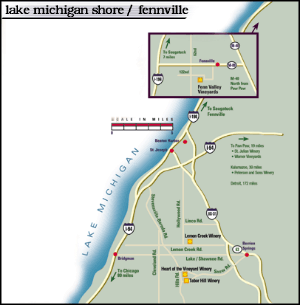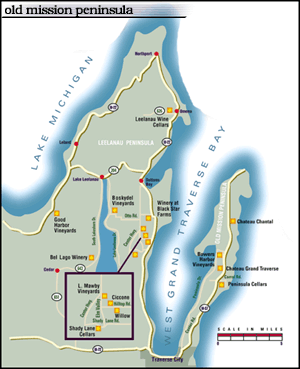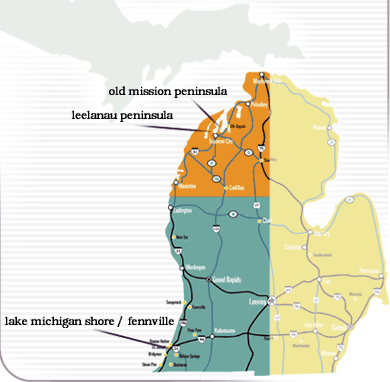The geography of wine in Michigan is an interesting one. Wine grapes are grown only in certain locations and under specific climatic and soil conditions. The lake effect of Lake Michigan is very effective at moderating the climate all along the western side of the lower peninsula of Michigan. In addition, much of the soil is sandy and well drained. As a result, summer temperatures do not get too hot, and winter temperatures do not get too cold, and the fields don't usually get waterlogged from excessive precipitation - in short, an ideal situation for growing fruit. In fact, Berrien Co. in the southwest of the State is one of the leading fruit producing counties in the nation. These ideal growing conditions led farmers to this part of the state since the mid-1800s.
Among the many types of fruit grown in this lake effect belt are grapes. Although most of the grapes have historically been grown for juice (these are American varieties such as Niagra and Concord), some vineyards have produced wine grapes since the late 1800s. Since the 1970s, the wine industry in Michigan has grown by leaps and bounds, from just one vineyard, St. Julian's, to over 25 in 2000. It employs many Michiganders in the growing, processing, and distributing sectors. Many wealthy retirees have moved to the Traverse Bay area and established vineyards in recent years, and the price per acre for wine grapes (around $1500) has resulted in some cherry and apple farmers switching to wine grapes.
|
|
 |
 |
Source: Michigan State University Department of Geography
There currently are four appellations (government recognized viticultural regions) in Michigan. These are the Lake Michigan Shore, Fennville, Leelanau Peninsula and Old Mission Peninsula. All Michigan vineyards reside inside these regions, but rather than produce appellation wines (like Bordeaux or Champaigne in France), Michigan wineries produce varietals, wines named according to grape variety (like they do in California). Some of the common varietals produced in Michigan are Riesling and Chardonnay.
Myth: Michigan wines are awful.
Fact: While the early Michigan wines made from Labrusca grapes often left a
lot to be desired ("Paw Paw" or "Michigan Wine" was a favorite drink
of winos in Chicago and Detroit prior to WW II), things have changed dramatically.
Michigan wineries now produce some of the finest wines in the world. Some Michigan
wines have won gold and silver medals in international competitions, beating out even the
Californian, French, Italian and German wines.
Next: Types of Wine (2 of 3)
Geo 333 would like to thank student Lauren Graves for her contribution to the Michigan wines web pages.
This material has been compiled for educational use only, and may not be reproduced without permission. One copy may be printed for personal use. Please contact Randall Schaetzl (soils@msu.edu) for more information or permissions.
